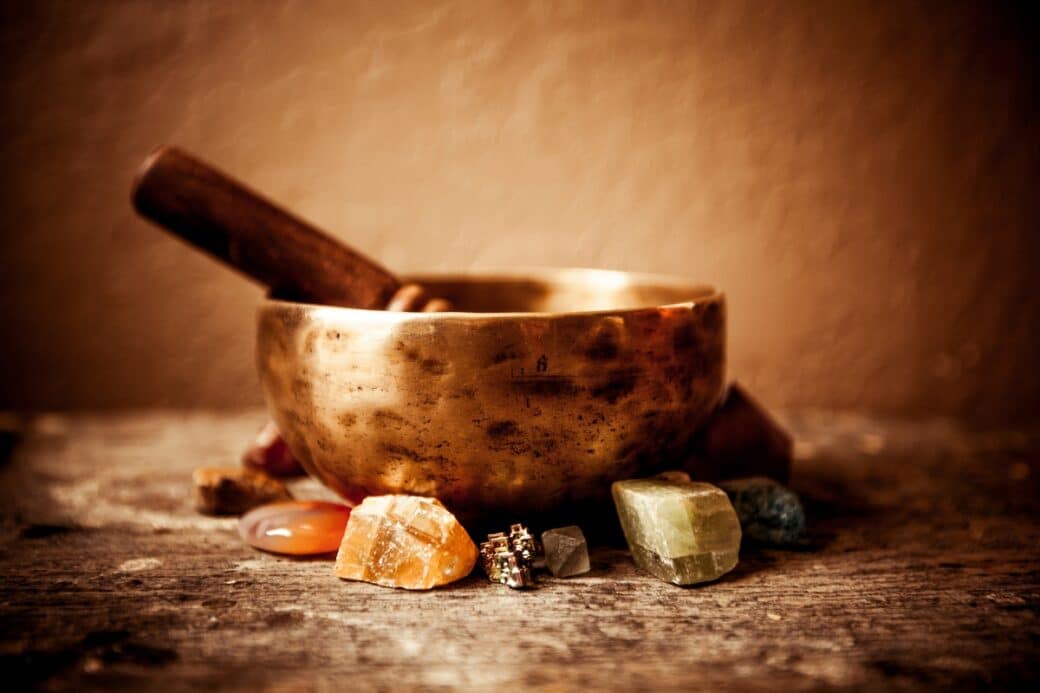Imagine yourself immersed in a world of captivating sounds and soothing vibrations, enveloped in an enchanting melody that resonates deep within your soul. Have you ever wondered how those mesmerizing singing bowls, with their intricate design and enchanting tones, are created? In this article, we will take a journey into the realm of craftsmanship, exploring the fascinating process behind the making of these unique instruments. From the selection of materials to the meticulous hand-hammering, each step unveils the skill and dedication required to create these magical instruments. So, sit back, relax, and prepare to embark on a journey of discovery as we unveil the secrets behind the art of crafting singing bowls.

How Singing Bowls Are Made: History of Singing Bowls
Origins of Singing Bowls
Singing bowls, also known as Tibetan singing bowls, have a rich and fascinating history that dates back thousands of years. Originating in the Himalayas, these mystical instruments were first used by Tibetan monks for spiritual and healing practices. The exact origins of singing bowls are shrouded in mystery, but they are believed to have been developed in the 5th century BCE by the Bon religion, a pre-Buddhist shamanic tradition in Tibet.
Symbolism and Cultural Significance
Singing bowls hold deep symbolism and cultural significance in various Asian traditions. In Tibetan Buddhism, they symbolize the unity of wisdom and compassion, with the sound of the bowl representing the perfect harmony achieved through the practice of mindfulness. The resonating sound of the bowl is believed to connect the physical and spiritual realms, creating a sense of tranquility and inner peace.
Traditional Uses of Singing Bowls
Throughout history, singing bowls have been used for a multitude of purposes. In Tibetan monasteries, they are an essential tool for meditation, prayer, and ceremonial rituals. The soothing sound produced by the bowls helps to calm the mind and enhance concentration during meditation practices. Singing bowls are also used in healing rituals to restore balance and harmony to the body, mind, and spirit. Their powerful vibrations are believed to have a therapeutic effect on the body, promoting relaxation and overall well-being.

Types of Singing Bowls
Bronze Singing Bowls
Bronze singing bowls are the most traditional and widely recognized type of singing bowl. They are typically made from a combination of metals, such as copper, tin, and other alloys. The precise blend of metals used in the manufacturing process determines the bowl’s unique sound and resonance. Bronze bowls are known for their rich and warm tones, which can vary from deep and grounding to bright and uplifting.
Crystal Singing Bowls
Crystal singing bowls offer a different experience compared to their bronze counterparts. These bowls are made from pure quartz crystal and are carefully crafted to produce a clear and vibrant sound. Crystal bowls are prized for their ethereal and angelic tones, which can transport the listener to a state of deep relaxation and tranquility. Their pristine resonance is believed to have a profound healing effect on the body and mind.
Japanese Rin Bowls
Japanese Rin bowls, also known as Singing Handbells, are a unique type of singing bowl that originated in Japan. These small handheld bowls produce a delicate and high-pitched sound when struck with a wooden mallet. Rin bowls are often used in Japanese Zen Buddhism for meditation and ceremonial purposes. Their gentle and pure tones help to create a serene and peaceful environment during meditation practice.
Materials Used in Making Singing Bowls
Materials for Metal Bowls
The traditional process of crafting metal singing bowls involves the use of various metals and alloys. The most common metals used are copper and tin, which are melted together to create a base mixture. Additional metals, such as silver, gold, and iron, may also be added to enhance the sound quality and resonance of the bowl. The quality and purity of these metals greatly impact the final sound produced by the bowl.
Materials for Crystal Bowls
Crystal singing bowls are crafted from pure quartz crystal, which is carefully selected for its clarity and resonance. The crystal is sourced from various locations around the world, including Brazil, the U.S., and China. The quality of the crystal, as well as its size and thickness, play a crucial role in determining the tone and vibration of the bowl. It takes skilled artisans many years of experience to identify and work with the right crystals for creating high-quality singing bowls.
Importance of Quality Materials
Using high-quality materials is of utmost importance in the creation of singing bowls. The choice of metals or crystal used greatly affects the tonal qualities and resonance of the bowl. Pure metals and flawless crystals produce superior sound and have a longer sustain. Skilled artisans carefully select and work with only the finest materials to ensure that every singing bowl crafted is of the highest quality, capable of producing beautiful, harmonious sounds.
The Process of Crafting Metal Singing Bowls
Melting the Metals
Crafting a metal singing bowl begins with melting the chosen metals. The metals are melted in a furnace at high temperatures until they reach a liquid state. This molten mixture is then carefully poured into a mold to create the desired shape of the bowl.
Shaping the Bowl
Once the metals have solidified, the bowl is removed from the mold and undergoes a shaping process. Skilled craftspeople use hammers and specialized tools to shape and refine the bowl’s form. This step is essential in determining the overall aesthetics and sound quality of the bowl.
Hand-Hammering Technique
One of the most critical aspects of crafting metal singing bowls is the hand-hammering technique. Experienced artisans meticulously strike the bowl’s surface using various hammers and mallets. Each strike creates a unique vibration and sound frequency, resulting in the bowl’s distinctive tones. The hand-hammering process requires precision and skill, as it is essential to achieve an even and consistent thickness throughout the bowl.
Polishing the Finished Product
After the metal singing bowl has been shaped and hand-hammered, it undergoes a polishing process to give it a smooth and lustrous finish. Craftsmen carefully buff the bowl’s surface until it gleams, ensuring that every imperfection is removed and the natural beauty of the metal shines through. The final outcome is a stunning and resonant singing bowl ready to be played and enjoyed.
The Process of Crafting Crystal Singing Bowls
Sourcing the Crystal
Crafting crystal singing bowls begins with sourcing high-quality quartz crystals. Expert artisans meticulously examine and select crystals that possess exceptional clarity, purity, and resonance. The process involves searching for crystals with minimal flaws or inclusions, as these imperfections can affect the bowl’s sound quality.
Melting and Molding Process
Once the crystals have been selected, they are carefully heated to a high temperature until they reach a molten state. The molten crystal is then poured into a mold that determines the size and shape of the bowl. The temperature and duration of the melting process are crucial in creating crystal singing bowls with optimal sound and durability.
Polishing and Smoothing
After the crystal singing bowl has solidified in the mold, it undergoes an extensive polishing and smoothing process. Skilled craftspeople use diamond-coated tools to remove any rough edges and imperfections, ensuring a smooth and flawless surface. This meticulous attention to detail enhances the bowl’s clarity and allows for a more resonant sound.
The Tuning Process
The final step in crafting a crystal singing bowl is the tuning process. Each bowl is carefully tested and adjusted to produce a specific sound frequency or musical note. Skilled artisans use a variety of tools, such as rubber mallets and tuning forks, to precisely tune the bowl to its desired pitch. This tuning process ensures that every crystal singing bowl possesses a clear and harmonious tone.
The Art and Importance of Tuning Singing Bowls
Understanding Sound Frequencies
Tuning singing bowls involves a deep understanding of sound frequencies and their impact on the human body and mind. Different frequencies have varying effects on our well-being, influencing our energy levels, emotions, and overall state of being. Skilled bowl craftsmen carefully adjust the frequencies of the bowls to create a harmonious balance that promotes relaxation, focus, and a sense of inner peace.
Methods for Tuning Bowls
There are various methods used to tune singing bowls to specific frequencies or musical notes. One common method is striking the bowl with a rubber mallet and listening for its sound. The craftsman then adjusts the bowl’s shape or thickness by carefully filing or adding small amounts of material until the desired pitch is achieved. Tuning forks and other harmonic instruments may also be used to precisely tune the bowls to specific frequencies.
Importance of Skilled Tuning
Skilled tuning is crucial in creating singing bowls that produce harmonious and therapeutic sounds. A well-tuned bowl not only enhances the listening experience but also maximizes the bowl’s healing properties. The subtle adjustments made during the tuning process can greatly impact the bowl’s resonance and the vibrational energy it emits when played. It is the skill and expertise of the artisans that make each singing bowl a unique masterpiece with its own distinct voice.
Decorative Aspects of Singing Bowls
Traditional Symbols and Imagery
Singing bowls are often adorned with intricate traditional symbols and imagery that hold deep cultural and spiritual significance. These symbols may include Om, the lotus flower, Tibetan mantras, and various Buddhist motifs. Each symbol carries its own meaning and serves as a visual representation of the bowl’s intended purpose or spiritual connection.
Modern Designs and Aesthetics
In addition to traditional motifs, modern singing bowls can also feature contemporary designs and aesthetics. Artisans are continuously pushing the boundaries of creativity, experimenting with new shapes, patterns, and color combinations. These modern designs cater to different preferences and allow individuals to choose a singing bowl that resonates not only with their ears but also with their visual sensibilities.
Techniques for Engraving and Decorating
The process of engraving and decorating singing bowls requires great skill and precision. Artisans use specialized tools to etch intricate designs into the bowl’s surface. These designs can range from simple patterns to elaborate scenes and motifs. Once engraved, the bowl may be further embellished with paint, gold leaf, or other decorative elements. These meticulous decorative techniques add an extra layer of beauty and craftsmanship to the singing bowl.
Uses and Benefits of Singing Bowls
Singing Bowls in Meditation
One of the most popular uses of singing bowls is in meditation practices. The soothing sound and vibrations produced by the bowls help to calm the mind and induce a meditative state. Meditating with a singing bowl can deepen the experience, allowing for increased focus and relaxation. The continuous resonance of the bowl acts as a point of concentration, aiding in the journey to inner stillness and self-discovery.
Healing Properties of Singing Bowls
Singing bowls are widely recognized for their healing properties. The vibrations emitted by the bowls have a harmonizing effect on the body’s energy centers, known as chakras. The sound frequencies produced by the bowls help to balance and restore the flow of energy within the body, promoting physical, emotional, and spiritual well-being. Many individuals use singing bowls as an alternative therapy to alleviate stress, reduce anxiety, and support overall healing.
Singing Bowls in Modern Psychotherapy
Singing bowls have also found their way into modern psychotherapy practices. Sound therapy, also known as vibrational therapy, is gaining recognition as an effective tool for emotional healing and stress reduction. Therapists incorporate singing bowls into their sessions to facilitate deep relaxation, release emotional blockages, and promote self-awareness. The soothing sounds of the bowls create a safe and nurturing space for individuals to explore and process their emotions.
Maintaining and Caring for Singing Bowls
Cleaning and Buffing Techniques
To keep singing bowls in optimal condition, regular cleaning and buffing are essential. Using a soft cloth, gently wipe the bowl’s surface to remove any dirt or dust. For polished metal bowls, a non-abrasive metal cleaner can be used to restore their shine. Crystal bowls should be cleaned with a mild soap and water solution. After cleaning, gently buff the bowl with a soft cloth to maintain its luster and remove any fingerprints or smudges.
Storing Singing Bowls
When not in use, it is important to store singing bowls properly to avoid damage. Metal bowls can be stacked, but it is advisable to place a soft cloth or padding between each bowl to prevent scratching. Crystal bowls, due to their delicate nature, should be stored individually in padded bags or boxes to protect them from impacts and unwanted vibrations.
Long-Term Maintenance Tips
To ensure the longevity of singing bowls, it is essential to provide long-term care. It is advisable to avoid exposing the bowls to extreme temperatures, direct sunlight, or moisture, as these factors can damage the bowls over time. Regularly inspect the bowls for any signs of wear or damage, such as cracks or chips, and address them promptly to prevent further deterioration. With proper maintenance and care, singing bowls can last for generations, providing countless moments of tranquility and healing.
Preserving the Art of Singing Bowl Craftsmanship
Challenges in the Singing Bowl Craft
The traditional craftsmanship of singing bowls faces several challenges in the modern world. One of the main challenges is the scarcity of skilled craftsmen. Due to the intricate and time-consuming nature of the craft, fewer young artisans are willing to dedicate themselves to this labor-intensive profession. Additionally, the growing demand for mass-produced singing bowls has led to a decline in the appreciation for the artistry and individuality of handcrafted bowls.
Supporting Traditional Craftsmen
To preserve the art of singing bowl craftsmanship, it is crucial to support and celebrate the work of traditional craftsmen. By investing in authentic and handmade singing bowls, individuals contribute to the preservation of an ancient art form and support the livelihoods of artisans who have honed their skills over many years. Recognizing the value of craftsmanship and honoring the wisdom passed down through generations helps ensure the continuation of this beautiful tradition.
The Future of Singing Bowl Making
While the challenges facing the singing bowl craft are significant, there is hope for the future. Increasing awareness and appreciation for the benefits and beauty of singing bowls can inspire a new generation of artisans to embrace this ancient craft. By fostering a renewed interest in traditional practices and encouraging innovation, the art of singing bowl making can continue to evolve and thrive, touching the hearts and minds of people around the world for generations to come.
In conclusion, the history of singing bowls is deeply rooted in ancient traditions, symbolizing spirituality, healing, and mindfulness. From bronze to crystal and Japanese Rin bowls, each type of singing bowl offers a unique and enchanting experience. The craftsmanship involved in creating singing bowls demands expertise and precision, from selecting the finest materials to hand-hammering and tuning the bowls to perfection. Singing bowls have a wide range of uses and benefits, from enhancing meditation practices to promoting healing and self-exploration. By caring for and preserving these magnificent instruments, we ensure that future generations can experience the beauty and therapeutic qualities of singing bowls.



